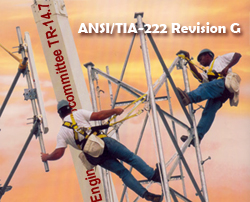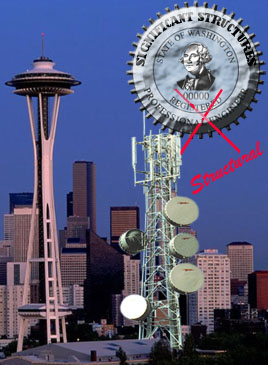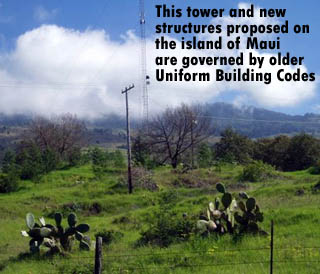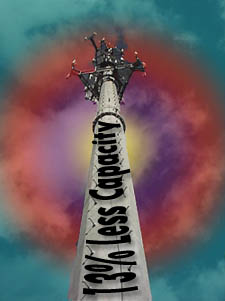|

|
New addendum in the works to Revision G
February 28, 2008 - Almost a year after the release of ANSI/TIA-222-G, Structural Standard for Antenna Supporting Structures and Antennas, work has begun on  the latest addendum to one of TIA's most popular and influential standards, by the TR-14.7 Structural Standards for Steel Antenna Towers and Antenna Supporting Structures Engineering Subcommittee. the latest addendum to one of TIA's most popular and influential standards, by the TR-14.7 Structural Standards for Steel Antenna Towers and Antenna Supporting Structures Engineering Subcommittee.
Invite offered to tower siting community
Organizations interested in participating in the process, including tower manufacturers, carriers, or any companies whose work involves tower siting, are encouraged to join the process at this time.
In the wake of the TR-14: Point-to-Point Communications Systems Engineering Committee meeting earlier this month in Las Vegas, the subcommittee agreed to add refinements based on recent changes in the reference standards used as the basis for Revision G, which was issued in August 2005, with an initial addendum added in April 2007.
Clarifications will be made in some sections of the standard based on external inquiries for interpretations and the committee's desire to provide general clarification. Minor editorial changes will also be included in the addendum. The committee's goal is to issue the addendum after all applicable balloting, during the first part of the year.
Brian Reese of AeroSolutions LLC serves as Chairman of TR14.7. John Erichsen of EET Engineering is Vice Chairman and Secretary.
The 222 Standard is reaffirmed or revised every five years. The committee has been discussing relevant issues for inclusion in Revision H. Potential subjects being considered include:
a. Base plate design methodologies/weld details of the base connection on
monopoles
b. Fatigue categories on welded joints
c. Maintenance and inspection: corrosion and fatigue on guyed cables
d. Qualification of manufacturers/material testing/submittals
e. Heavy icing events
f. Expanded information related to concealed monopole structures
g. Broadcast antenna degradation issues
For more information on TR-14 and applicable standards, contact Marianna Kramarikova at 703.907.7706 or mkramarikova@tiaonline.org .
|
Washington board asked to interpret legislation that would halt tower design work by P.E.s
February 6, 2008 - Professional engineers that currently design communications  structures in Washington may be prohibited from providing those services after June, or at the latest, December 31, 2010. structures in Washington may be prohibited from providing those services after June, or at the latest, December 31, 2010.
During the Washington State 2007 Legislative Session, Substitute Senate Bill 5984, allowing only structural engineers to provide engineering services for "significant structures", was passed by the House 98 to 0 and signed by Gov. Christine Gegoire on April 21.
The provisions of the bill, effective July 1, detailed many structures that were deemed to be significant such as buildings housing explosives, hospitals, fire and police stations, and government communications centers. Among others, it also listed "Structures exceeding 100 feet in height above average ground level."
Please see: Standard group objects |
|
Honolulu's revamped building code introduction signals another year or two wait for TIA-222-G
July 25, 2007 - Although Honolulu is the most progressive city in Hawaii in updating its building codes, their adoption of the International Building Code 2003 will keep Revision F of TIA-222 as the design criteria for at least another year or two before the city adopts the IBC 2007 Supplement which requires Revision G.
For Honolulu, the adoption of IBC 2003 was the first change to the city's building code during the past 10 years. The code is administered by the City's Department of Planning and Permitting.
In signing the measure, Mayor Mufi Hannemann said, "This bill represents a partnership between the City and the many individuals and organizations that provided invaluable support and advocacy in the preparation of the building code update."
Many of Oahu's top construction professionals offered testimony during the City Council's hearings on the measure in March. Gary Okamoto of Wilson Okamoto Engineers and Planners, said, "We feel that adoption of the current building code would greatly benefit the City and County of Honolulu. There is an update in building codes nationwide and adoption will provide Honolulu with a building code that is commensurate with those that are in use throughout the rest of the nation."
Hawaii Governor Linda Lingle signed legislation adopting the 2006 International Building Code statewide, effective July 1, and establishing a state building code council.
Hawaii was the only state that had not adopted the IBC, which replaced the Uniform Building Code several years ago.
The four counties have been operating under various versions of the UBC drafted in the 1990s, with the Big Island using the oldest, drafted in 1991.
|
|
Jacksonville planners' decision could greatly reduce capacity of cell towers
May 24, 2007 - The Jacksonville, Florida Planning Commission has voted 5-2 in favor of keeping a Class III structure classification for all towers used in cellular communications, according to Morrison Hershfield. The consulting engineering and management firm said the ruling will adversely impact the structural capacity of cell towers, reducing them by approximately 13% on average.
Revision G of the tower standard provides three classification categories for towers based on their expected reliability criteria and/or threat to human life. Class I, the lowest reliability rating, is used for optional communication systems, such as residential wireless, amateur and CB radio systems. expected reliability criteria and/or threat to human life. Class I, the lowest reliability rating, is used for optional communication systems, such as residential wireless, amateur and CB radio systems.
Class II is the default classification that includes cellular and PCS communications, as well as television and radio broadcasting.
Class III is the highest reliability rating and is meant for structures used primarily for essential communications such as national defense, rescue or disaster operations. Most engineers performing analysis on cellular communication towers will use a Class II classification.
A higher classification implies that the structure must be analyzed to more stringent requirements. This has the net effect of decreasing the allowable capacity of the tower and reducing the number of tenants that may be added.
Tallahassee has similar requirements in place, but will now accept a Class II structure classification for cell tower analysis, provided the engineer explicitly states in the analysis report that the tower is not used for essential communications.
Florida is currently the only state where Revision G is legally applicable. The 2004 Florida Building Code was amended December 8, 2006 referencing the newest revision of the structural standard for antenna supporting structures and antennas.
Later this month Revision G will be referenced in the IBC 2006 supplement that is expected to be approved. If a building authority currently uses IBC 2006 it may be necessary to alert them to the supplement since most local jurisdictions do not adopt them once they are published.
Design requirements in the same Florida county can change from community to community based upon local building department requirements. Oftentimes plans examiners are not aware of TIA-222's latest revision.
|
|